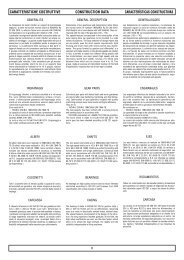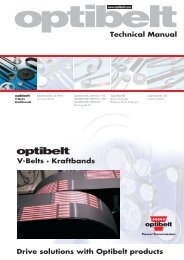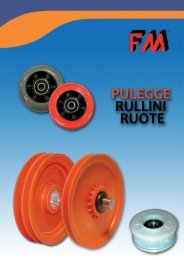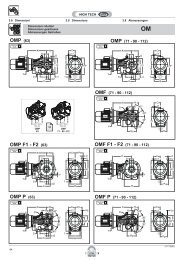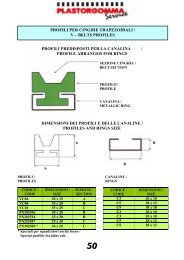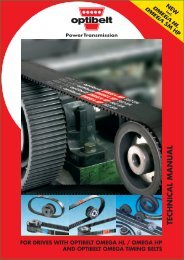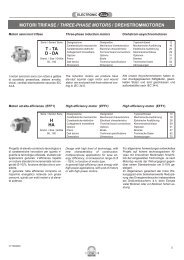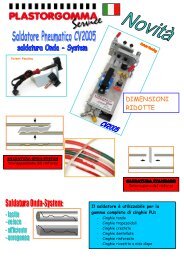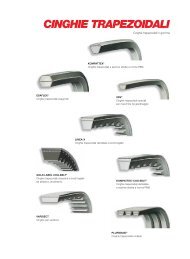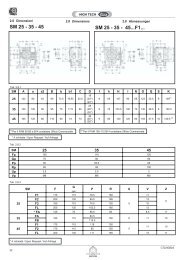Technical Manual for Ribbed Belt Drives
Technical Manual for Ribbed Belt Drives
Technical Manual for Ribbed Belt Drives
- No tags were found...
Create successful ePaper yourself
Turn your PDF publications into a flip-book with our unique Google optimized e-Paper software.
Design Hints<strong>Ribbed</strong> <strong>Belt</strong> TensionII. <strong>Belt</strong> Tensioning using a ”Length AdditionalValue”It has become evident that span deflection methods are notalways the ideal checking procedures <strong>for</strong> ribbed belts. Thefollowing very simple method <strong>for</strong> the determination of the belttension is there<strong>for</strong>e recommended:1. Calculate the static belt tension “T”.500 · (2.03 – cT ≈ 1 ) · P B+ k · v 2c 1 · z · v2. The outside length L a of the <strong>Ribbed</strong> <strong>Belt</strong> should be measured onthe top surface with the belt slack prior to fitting it to the drive.Measurement may also be taken on the drive itself, but withouttension.Example::P B = 23.4 kWc 1 = 1.0v= 16.6 m/sDrive specification with Optibelt-RB <strong>Ribbed</strong> <strong>Belt</strong> 12 PL 1075T ≈500 · (2.03 – 1.0) · 23.41.0 · 12 · 16.6+ 0.036 · 16.6 2 ≈ 70 NWhen fitted <strong>for</strong> the first time, the tension should bemultiplied by a factor of 1.3.T ≈ 1,3 · 70 ≈ 91 N3. Calculate the length additional value “A” by using the <strong>for</strong>mula:A ≈ L est · RLength measured on the back of the belt whilst slackA ≈ 1075 · 0.00264 ≈ 3 mmR = Stretch factor from table 19 page 43.4. This length additional value A should then be added to themeasured outside length (from step 2).L a ∗ ≈ L a + ATighten the belt until the length measured around the outside is1103 mm. The belt is then correctly tensioned.L a ∗ ≈ 1100 + 3 = 1103 mm5. The ribbed belt should then be tensioned until the outside lengthL a * calculated in step 4 is obtained. The belt tension will then becorrect.6. If the drive is to be retensioned, the ribbed belt must first beslackened off so that it can be measured in a stress freecondition. The procedure as detailed in steps 4. and 5. is thenrepeated.IV.Checking the <strong>Belt</strong> Tension by Speed MeasurementIn this method, the belt tension is checked using the theoreticalslip. The speeds of the driver and driven pulleys are measuredfirst in an unloaded and then in a loaded condition.III. Checking the <strong>Ribbed</strong> <strong>Belt</strong> Tension by Measurement ofthe Static Shaft LoadingA very accurate method <strong>for</strong> the setting of the correct belt tensionis by direct measurement of the static shaft loadingusing the <strong>for</strong>mula:S = Slip (%)n 1L = Speed of driver pulley, unloaded(r.p.m.) (min -1 )n 2L = Speed of driven pulley, unloaded(r.p.m.) (min -1 )n 1B = Speed of driver pulley,under load (r.p.m.) (min -1 )n 2B = Speed of driven pulley,under load (r.p.m.) (min -1 )Formula <strong>for</strong> the calculation of slip:S a ≈ 2 T · sinβ2· zn 1L /n 2LS = (1 – ) · 100n 1B /n 2B42This checking method, however, does call <strong>for</strong> specialisedmeasuring instruments.At the rated loading, the slip should not exceed 1%. The beltservice is considerably shortened due to excessive flank wearwith an unacceptably low initial tension or under extremeloading conditions, with slip in excess of 2%.



